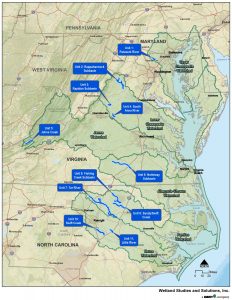Increased Stream Protection in MD, VA, and NC Designated Habitats for Yellow Lance
The yellow lance (Eliptio lanceolata), a federally threatened species of freshwater mussel, will be provided additional protection along specific reaches of rivers and streams in Maryland, Virginia, and North Carolina following the U.S. Fish and Wildlife Service’s (USFWS) issuance of the Final Rule; the new regulation will be effective on May 10, 2021. The USFWS made one change from the proposed rule we discussed in our February 24, 2020 edition of Field Notes – a revision of the Special Management Considerations or Protections language to clarify the need to reduce “improper forest management or clearcuts within riparian areas.”

The critical habitat includes 11 watersheds comprising 319 river miles.
Where is the Critical Habitat?
These areas, noted on our map, have been determined to be essential to the survival of the species, and require special management considerations or protection (e.g., certain activities may be restricted from occurring in these areas). The USFWS has specifically identified 11 watersheds (critical habitat “units”) comprising 319 river miles as critical habitat. Click the name of the watershed to see a detailed map for each:
- Patuxent River (Montgomery and Howard Counties, MD)
- Rappahannock Subbasin (Rappahannock, Fauquier, and Culpeper Counties, VA)
- Rapidan Subbasin (Madison and Orange Counties, VA)
- South Anna River (Louisa County, VA)
- Johns Creek (Craig County, VA)
- Nottoway Subbasin (Nottoway, Lunenburg, Brunswick, and Dinwiddie Counties, VA)
- Tar River (Granville, Vance, Franklin, Nash Counties, NC)
- Sandy/Swift Creek (Vance, Warren, Franklin, Halifax, Nash Counties, NC)
- Fishing Creek Subbasin (Vance, Warren, Franklin, Halifax, Nash Counties, NC)
- Swift Creek (Wake and Johnston Counties, NC)
- Little River (Johnston County, NC)
Typical habitat for the yellow lance includes running waters of all sizes, ranging from main channels of drainages to creeks as small as a meter across. They are found in stable areas with clean substrates, from gravel to coarse or medium sand. They can be found buried in substrates in riffle areas.
What does this mean for me?
Any projects within the designated units requiring federal agencies to consult with USFWS under Section 7 of the Endangered Species Act will have to address this species and the critical habitat. Examples of such actions would be wetlands permits, FEMA approvals, or projects with federal funding.
Threats to the yellow lance within the units vary and include excess sediments from stormwater runoff, high E. coli levels, excessive nitrogen and phosphorus inputs, low pH, low dissolved oxygen, and point source discharges of wastewater. Projects with disturbance within these units may be required to show how they address unit-specific threats.
Questions?
If you have any questions or have a project that could impact a critical habitat, please contact Ben Rosner and Bob Kerr in Virginia, and Mike Klebasko in Maryland.
